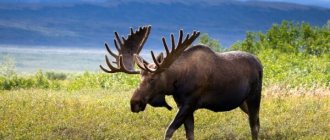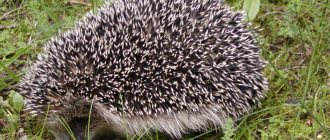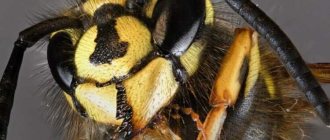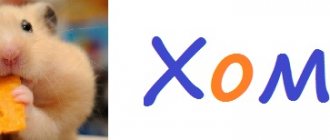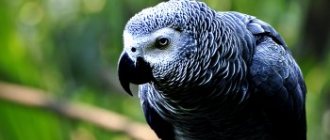- Wild animals
- >>
- Birds
The Hyacinth Macaw (Anodorhynchus hyacinthinus) is the largest flying parrot. Its length reaches one meter. It has a distinctive coloration, which determined the name of the species. It has a neat head, eyes framed by bright yellow circles, and has a large rounded beak. Has a developed intellect. Hears and recognizes human speech and natural sounds. It has been proven that the hyacinth macaw not only repeats human speech, but reproduces words quite meaningfully. Asks and answers questions, takes part in the conversation.
Origin of the species and description
Photo: Hyacinth Macaw
The hyacinth macaw belongs to the phylum Chordata, class of birds, order Psittaciniformes. One of two described species of the genus A. hyacinthinus.
Anodorhynchus hyacinthinus or the great hyacinth macaw was first described and sketched in detail by British ornithologist John Leithen in the late 18th century. An English naturalist described the bird based on a taxidermy specimen sent to England from the colonies. The first work describing a large blue bird with a prominent beak dates back to 1790 and is entitled Psittacus hyacinthinus.
Video: Hyacinth Macaw
The modern name of the largest flying parrot on the planet is Anodorhynchus hyacinthinus. Body length from head to tail is from 100 to 130 centimeters. The plumage is an amazing sapphire color. The head is small, neat, completely covered with small feathers. A spectacular ring around the eyes and a stripe framing the beak like a mustache of bright yellow color. The hyacinth macaw can be recognized by its long tail and large, powerful beak. Habitat: Brazil, Bolivia and Paraguay.
The second representative of the species, the small hyacinth macaw Anodorhynchus leari, was described by the nephew of Napoleon Bonaparte in the mid-19th century. Carl Bonaparte described the bird exactly a year before his own death.
Carl Bonaparte noted several differences between the first and second species of parrots. The Lesser Hyacinth Macaw has the same coloration, but the wings are slightly darker, and the head, chest and belly have a green tint. The main difference is the size and weight of the bird. The body length was 75 cm and the weight was 800 grams. Lives in hard-to-reach areas in North-East Brazil.
Tame a Giant
Thanks to its well-developed intellect, the macaw quickly gets used to people, it makes good contact and quite quickly understands the language the owner speaks. Over the course of several years of living in a family, the macaw learns to imitate the speech style of each member of its family and knows how to joke, answering questions or provoking a dialogue with a person on its own.
They became famous for their tenderness towards people and humane habits in their character. They are friendly in everyday life, excellent companions for adults and children of all ages. Thanks to the analysis of human speech, they can clearly distinguish who is addressing them and turn their heads towards the speaker.
The largest macaw studied weighed 1.8 kilograms.
Appearance and features
Photo: Hyacinth macaw parrot
Hyacinth macaws are the largest flying parrots in the world. With a weight of 800 grams to 1 kilogram, which is significant for birds, they are able to cover not very long distances. The bird leads a sedentary lifestyle. It does not migrate, does not change habitats, and remains in the traditional territories of its species all its life. However, in search of food, it can fly tens of kilometers, and then return to the nesting site at night.
Hyacinth macaws make their homes in the hollows of the Panama tree. The tree belongs to the malvaceae flowering family and has soft and pliable wood, which allows parrots to expand and deepen natural cavities. Parrots choose large and fairly comfortable recesses. If necessary, line the bottom of the hollow with dry leaves, sticks and feathers, which are found in the crowns of trees and on the ground. The nesting height can reach 40 meters above the ground.
Due to their large stature and keen intelligence, hyacinth macaws are called gentle giants. Parrots received this nickname for their ability to correctly use affectionate words. An intelligent bird speaks the languages of its owners, analyzes speech perfectly, enters into dialogues, and knows how to joke. The Blue Macaw is balanced and friendly, making a good companion.
The largest known hyacinth macaw in the world reached 1 meter in length. Its weight is 1.8 kg. Wing length 42 cm. The tail is long and pointed. The magnificent blue wings change color to a lighter tone at the ends. Neck color with a slight smoky tint.
Lifestyle
The hyacinth macaw parrot does not like noisy flocks. Birds live in groups of 10-12 individuals. Thanks to their impressive dimensions, they can fend for themselves in their natural environment. Departure from the nest occurs early in the morning.
In search of food, parrots can fly over distances of several tens of kilometers. The hot part of the day is spent in trees, hiding under their crown from the scorching rays of the sun.
They usually spend the night in the same place.
Where does the hyacinth macaw live?
Photo: Great Hyacinth Macaw
The hyacinth macaw lives in thinned, sparse and food-rich forests of South America. The original habitats are located in the jungle. This part of the forest is located along tropical rivers. Rich in fruits, berries and nuts. There is enough food here, tree branches serve as protection and at the same time there is enough space for flights.
Gentle giants can be found in large areas of Bolivia covered by a network of tropical rivers, for example, in the subtropical forests of the foothills. The traditional habitat of the hyacinth macaw is in the Amazon River basin, as well as in the swampy area of Pantanyal do Rio Negro.
There are three main known habitats in South America:
- the Pantanal tectonic basin in Brazil, adjacent eastern Bolivia and northeastern Paraguay;
- in the Cerrado region in eastern Brazil (Maranhao, Piaui, Bahia, Tocantins, Goiás, Mato Grosso, Mato Grosso do Sul and Minas Gerais);
- open areas along the Tocantins, Xingu, Tapajos rivers and Marajo Island in the eastern Amazon basin of Brazil.
Small populations are found in palm swamps, open woodlands and other semi-open wooded areas. The Hyacinth Macaw avoids dense, humid forests. These parrots are found in savannah meadows and dry thorny forests.
Video about planting hyacinths
Proper lighting and soil for hyacinths. It is much better to plant a flower in open ground. We recommend watching the video!
Growing hyacinth is a process that requires attention to the plant and careful agricultural technology. With proper care, tall candles of hyacinth inflorescences will delight you throughout the flowering period. And the variability of use in various garden and flower groups will pleasantly surprise both beginners and experienced landscape designers of their garden. We wish you good luck in cultivating these amazing and delicate flowers - hyacinths!
What does the hyacinth macaw eat?
Photo: Hyacinth Blue Macaw
Much of the hyacinth macaw's diet is based on nuts from the local Acuri and Bokayuwa palms. Strong beaks are adapted for eating hard kernels of nuts and seeds. Blue parrots can even crack coconuts, large Brazil nuts and macadamia nuts.
The Great Blue Parrot's food preferences revolve around nuts. The hyacinth macaw's diet includes Brazil nuts, cashews, almonds and hazelnuts. Birds of this species have dry, rough tongues. They are adapted for peeling and extracting fruits.
The blue macaw is not averse to picking up the acuri nut. Despite the fact that this nut is excessively hard and in its fresh form is too much for a parrot, birds have adapted to look for it in the droppings of cattle. Smart birds fly to pastures specifically to feast on this nut.
In addition, they eat fruits and plant seeds. Don’t mind eating bakuri, mandakaru, pinyau, sapukai, peki, inga, cabasiña do campo, pitomba, buriti, karguata, white jabuticaba, guava, guarana and other fruits. In the Pantanal, hyacinths collect the nuts of the palms Acrocomia aculeata, Attalea phalerata and Acrocomia lasiospatha.
General characteristics
Speaking about our blue beauties, it is worth mentioning their wonderful beak. This organ performs many functions. We have already talked about the ability to crack the hardest nuts, what else?
General characteristics of a parrot
A parrot's beak is a full-fledged hand. Performs the following functions:
- tactile, tests surfaces for strength, safety, suitability for anything;
- defensive, there is nothing to say here, adult macaws have no natural enemies at all;
- manipulative, with the help of their beak and tongue, macaws can perform both rough work (for example, hollowing out a nest) and the finest operations (for example, grooming a partner);
- third point of support: macaws are excellent tree climbers, clinging alternately with their paws and beak, they can move in all directions along large and small branches.
It’s not for nothing that we mentioned nests - to breed their offspring, hyacinth macaws build hollows in wide trunks up to half a meter deep. Over time, they refine them, and the result is a fairly spacious house, covered with wood chips.
characteristics of the hyacinth parrot
Features of character and lifestyle
Photo: Hyacinth macaw bird
The Hyacinth Macaw forms pairs. Families gather in small flocks. This makes it easier to find food and care for the chicks. In search of food, parrots fly several kilometers away from their nests and always return back.
The Great Blue Parrot is a very curious bird that communicates with other representatives of the fauna of South America. Reproduces the sounds of wildlife and imitates other animals. In nature, life expectancy can reach 90 years.
It has a sharp, guttural whistle. He can wheeze, whistle and grumble. The sound made by the hyacinth macaw can travel several kilometers. This is how parrots warn of danger. Being in a good mood, they can communicate with their fellow tribesmen for a long time, walking or swinging on tree branches.
In captivity they listen to and understand music. They move to the beat, dance and make sounds to the beat of the music.
Birds have high intelligence. In captivity they show affection for their owners. They imitate speech. Understand words and commands. Parrots of this species are used as circus performers. They are touchy, remember bad treatment, get offended by lack of attention, get sad and lash out. Subject to stress. As a sign of protest or sadness, they may pluck their feathers and refuse to eat.
Nutrition
The main food supply for parrots is palm nuts. Moreover, the subspecies from the Pantanal region feeds exclusively on the fruits of palm trees of the Mucuy genus. Adherence to a monotonous diet makes it difficult to keep birds in captivity, especially if they were caught in adulthood.
Diet of hyacinth macaw
In addition to nuts, hyacinth macaws can eat fruits and berries. But there is one peculiarity here - the acids contained in soft fruits bother the bird’s stomach. To mitigate this effect, macaws ingest clay, finding it on steep river banks. The alkaline base of the soil neutralizes irritation.
Social structure and reproduction
Photo: Hyacinth Macaws
Nesting time for the hyacinth macaw occurs from July to December. Parrots use ready-made tree hollows or rock crevices as nests.
In some ways, the hyacinth macaw is dependent on the toucan, which distributes the seeds of the manduwi tree - Sterculia apetala. This is what is most suitable for nesting. Its soft and pliable wood is suitable for expanding and enlarging nests. But unfortunately, the toucan is also responsible for eating the eggs of the hyacinth macaw.
Great blue parrots begin to mate at 7 years of age. Males court females, offering them the most delicious pieces of fruit and nuts, affectionately tugging at feathers and caressing them.
Courtship ends with mating and egg laying. There are no more than two of them in the clutch. As a rule, out of two chicks hatched, only one survives. The reason is that parrots lay eggs several days apart. The chicks hatch at the same intervals. The younger chick cannot compete with the older one in claims for food and, as a rule, dies from malnutrition.
Incubation lasts about 30 days. The male cares for the female while she incubates the eggs. About three months after incubation, the chicks leave the nest but remain dependent on their parents for up to six months.
Content
The young ones are very well tamed. Since ancient times, they have been tamed by indigenous people, among whom it was one of their favorite birds. Known in Europe since the 17th century. Capable of pronouncing several dozen words. Popular as pets because of their beauty and ability to imitate human speech, they are difficult to keep and require a lot of attention, unlike traditional pets - dogs and cats. Very intelligent.
They have a strong, noisy voice, which creates inconvenience for neighbors (distracting them with toys and communication). They constantly gnaw on various objects, even biting through steel wire.
They eat a variety of plant foods: nuts, seeds, grains, fruits and vegetables (including dried), herbs, etc.
Some foods (cherry pits, avocados, chocolate and coffee) are poisonous to birds.
Macaw parrot in flight
Natural enemies of hyacinth macaws
Photo: Great Hyacinth Macaw
In the wild, large blue parrots have a lot of enemies. First of all, these are predators from the order of birds. The parrot habitats include turkey vulture, yellow-headed cathart, king vulture, osprey, as well as cayenne and long-billed kites. Harpies, ospreys and more than 12 species of hawks are not averse to feasting on parrots.
Some birds actively hunt hyacinth parrots, while others are not averse to feasting on their eggs. Toucans and jays have been spotted destroying parrot nests. Sometimes wild cats, snakes and a large number of raccoons make raids on the masonry. Noses deftly climb trees and climb into nests. There are cases when they entered into fights with parrots over clutches.
Large and medium-sized tree snakes also hunt for more than just eggs and newborn brood. Among the most dangerous snakes are boa constrictor, anaconda, and lizards. Wild forest cats are not averse to feasting on parrots: ocelot, forest tiger cat and straw cat.
However, the main danger for the hyacinth parrot is humans. Beautiful feathers and a valuable beak make the hyacinth macaw a desirable prey. Its feathers are used to decorate accessories and to make souvenirs and amulets.
The hatched chicks are taken from the nests for further resale to private collectors and zoos. Due to its quiet and docile nature, the hyacinth macaw is a desirable acquisition. The blue parrot does not breed in captivity. Large parrots are affectionate and sociable creatures. Their ability to communicate and reproduce speech raises their price.
Indians of some tribes from southern and central Brazil use hyacinth parrot feathers for traditional headdresses and national jewelry.
In addition, birds suffer from loss of natural habitat. Selvas and tropical rainforests are disappearing as a result of human activity. Forests are cut down and burned. This is how people free up land for new farmland and industrial construction.
Instructions
In order to obtain this or that shade, you need to know the laws of color mixing. Although the human eye can distinguish hundreds of tones, in reality only three main colors can be distinguished, thanks to which the others are obtained. Red, blue and yellow are basic colors and cannot be created by mixing them. But when combined in different proportions and quantities, they can create any desired shade.
For example, from a combination of blue and yellow, green, blue and red are obtained; when mixed, they give a dark blue tint, and by combining equal parts of all three colors, you can get black. By experimenting with the amount of one color or another, you can endlessly obtain new shades. We should not forget that indiscriminate mixing of different dyes leads to the formation of dirty, unattractive colors.
- You should not mix more than three different colors, as this will result in a “dirty” shade.
- Some paints can react chemically with each other, causing a change in their saturation, lightness, or hue.
- Some watercolor paints, such as cobalt blue or cadmium red, lose their ability to cover the surface evenly when in contact with large amounts of water.
- Gouache paints often become lighter when dry. Also, you should not take them out of the can with a brush: wet bristles capture paint of varying thicknesses, and this subsequently causes unwanted streaks to form on the paper.
- It must be remembered that each color has an infinite number of shades, from cold to warm. Mixing one shade with another gives a completely new one.
- White paint, as a rule, softens colors, making them more delicate and blurry, while black paint, on the contrary, mutes and weighs down the color.
You can clearly see how to mix paints by looking at the color wheel, in which three basic simple colors are placed at equal distances from each other, with additional colors extending from them. This table clearly demonstrates the possibilities and consequences of mixing colors.
Population and species status
Photo: Hyacinth macaw parrot
The hyacinth macaw is an endangered species due to black market trade, poaching and habitat loss. According to official data, about ten thousand birds were taken from the wild in the 1980s alone. About half were destined for the domestic Brazilian market.
In 1972, a Paraguayan dealer received 300 fledglings, only 3 birds survived. Hunting for young individuals has led to depletion of the population. The population is also affected by the disappearance of traditional habitats. The habitat is changing due to ranching and mechanized farming, as well as due to the construction of hydroelectric dams.
Annual grass fires started by farmers destroy parrot nesting sites. Bird nesting sites are no longer suitable for life and reproduction. In their place were plantations of vegetables, fruits and tobacco. Parrots belonging to the family Psittacidae are endangered. 46 out of 145 species are at risk of global extinction.
By the beginning of the 21st century, the number of large blue parrots did not exceed 3,000 individuals. The threatened situation of the species forced people to introduce urgent measures to preserve rare birds. Over the past two decades, the population has doubled to 6,400 individuals.
A Brief History of the Color Genetics of Budgerigars
Through long-term selection, at present, in the colors of budgerigars, there are about 32 primary mutations, which in turn give more than a hundred secondary ones. It took scientists many years so that today we can enjoy the incredible variety of colors of budgerigars. Thanks to the laws of inheritance, breeding a particular color now becomes possible even for ordinary bird lovers.
In 1872, as a result of long work, breeders managed to breed a yellow budgerigar. And only in 1878. Belgian scientists introduced the blue budgerigar to the world, but offspring of this color were obtained only in 1910.
Photo of a blue budgerigar:
Thanks to the blue wavy, dark blue and dark green parrots were born.
White budgerigars were bred in France in 1917, and 7 years later albinos appeared in Germany, and parrots of variegated colors appeared in Denmark. We owe the purple and brown colors to England.
How to effectively combine yellow and blue (blue) in clothes?
“Is it possible to combine such opposite things in one ensemble?!” - you ask. In fact, it is not only possible, but also necessary! Think of it this way: the combination of blue and yellow shades is like the bright sun on a cloudless sky. And everything that is dictated by nature itself is perfect and doomed to success.
If you took a muted yellow, then blue should also be used in the same way, and vice versa, if the light tone is chosen to be warm, then the dark one should match and be no less saturated. Everything will turn out well, the main thing is not to overdo it!
Classic style
The office dress code dictates its own rules that must be obeyed. But it should be done exclusively beautifully and attractively.
For a professional look, consider dark shades of blue and muted yellow.
You can opt for a mustard blouse and an ultramarine or sapphire skirt, or wear a lemon dress and throw a cobalt jacket over your shoulders. You definitely won’t go unnoticed, but you won’t raise any unnecessary questions either.
Romantic
To go on a date or meet with friends, you can use, on the contrary, light and airy colors. For example, an elegant azure sundress with a thin yellow belt and matching earrings will create the effect of an inspired and gentle person, which will definitely affect your image in the best way.
Examples of successful combinations in the photo.
Try on sky-colored trousers with a flowy beige-yellow blouse. And if you dilute the look with a couple of interesting accessories, for example, a sunny handbag or a thin blue bracelet, then all eyes will definitely be turned only to you!
In autumn, you can take a closer look at bright outerwear.
Sports
Such an image simply requires fiery colors. In order not to overdo it, use the 1/3 rule: in a bright set, make one of the colors the main one, and add the second as details in the specified proportion.
For example, classic blue jeans, a sweatshirt a shade lighter and a yellow raincoat (or jacket).
Don’t be afraid to play with flowers, because with their help you can lift your mood and provide a good boost of energy.
Free street style removes all barriers. Any experiments are possible here.
Evening dress
Deep blue seems to be created for social events and expensive parties. Just think about a long dress in this color...
But how can you beat yellow here? The answer is simple - pay attention to jewelry, use gold
A lace dress looks elegant.
This could be rich embroidery, an elegant sparkling clutch or a belt framing your waist, or golden shoes. One thing is for sure: in this form, you can even walk along the red carpet to non-stop applause!
Stand out in style! Add variety and bright colors to your wardrobe, and then have fun mixing them into one outfit. Rest assured, you will definitely like it!
Color options
In general, the colors of birds do not affect their character. Budgerigars can be divided into 2 groups based on color. The first of them includes individuals with normal wavy, the second - variegated ones, such as albinos, harlequins, etc. As for blue birds, they belong to the first group.
Primary colors have their own gradation, for example, blue parrots can be classified by shade as follows.
- The classic blue parrot is a bird with a blue belly, back and chest. The predominant color on the muzzle is white, the cheeks have a purple tint, the head has black feathers, and the tail has blue feathers. The waves are painted black.
- The second group is blue and gray. The main difference from representatives of the classic blue species is the predominance of gray or deep blue tone. Sometimes blue-gray birds can be seen.
- And finally, purple parrots. This shade predominates on the cheeks, back and stomach. The tail feathers are blue-green. The muzzle is white.
general information
You will probably remember the appearance of this bird for a long time. The length of its body can reach as much as sixty centimeters. And the weight is four hundred grams. However, what makes it noticeable is not its significant body dimensions, which differ from the size of most domesticated pets, but its incredibly beautiful blue plumage, which is absent only on the front part of the bird.
Another interesting feature characteristic only of young individuals of the blue macaw photo, which can be seen on our website, is a light stripe exactly in the middle of their beak. However, with age it disappears, and the beak becomes uniformly dark. However, you are unlikely to be able to remember at least one species of bird that would have the same interesting feature.
Varieties
There are more than 15 species of macaws. Basically, birds are distinguished by a number of characteristics from wing length to plumage color.
Chestnut-fronted (Northern Macaw)
The bird is medium in size: reaches 50 cm in length, half of which is in the tail. The body is covered with green feathers with a blue tint. There are reddish spots on the shoulders. The skin on the sides of the head is white with tiny brown feathers. The plumage area above the beak is chestnut-colored, which is how the parrot got its name. The bird lives on average 30 years. The North Macaw can be purchased at the nursery.
Red
One of the largest among the macaw species. Its size exceeds 80 cm. The upper part of the massive beak is white, the lower part is dark gray. Wings with yellow and blue feathers stand out clearly against the background of the whole body. The bright plumage of a rich red hue does not mean that the bird is poorly camouflaged. When a parrot sits hidden, it is impossible to notice it. And only a sharp croaking cry reveals the hiding macaw. In flight, the bird reaches a speed of 50 - 60 km/h.
Green-winged
The coloration resembles the red macaw, only the green-winged one has a different shade of the upper coverts. There is no yellow color at all. The body length including the tail reaches 90 cm. The parrot is incredibly noisy when it feels safe. Capable of pronouncing words, but noticeably inferior to representatives of other species. It is difficult to keep such a large bird at home. It requires a special approach and large financial costs.
Bluehead (mountain)
The smallest parrot among all macaw species is no more than 40 cm in length. The main shade of the feathers is green, the head and part of the wings are blue. There are reddish spots on the tail. The birds are found in the tropical forests of Brazil. They live in small flocks and form pairs during the nesting period. The population size has decreased to 200 individuals, so the species is listed in the International Red Book.
Red-bellied
It cannot be said that this species of macaw is large - it grows only up to 50 cm. It has a contrasting color: a yellow facial mask stands out against the background of olive-green plumage. The color of the wings is not uniform. Green stripes alternate with blue and brown. There is a brick-red spot on the stomach. It is extremely difficult to keep a bird, mainly because of feeding. It does not breed in captivity and lives only in zoos.
Large hyacinth
The largest representative of the macaw genus. A tail of the same length is added to the half-meter body. An adult bird weighs no less than 1200 g. What makes the big one interesting is its bright blue color. The bird is very strong: with its huge beak it easily cracks hard nuts and bites thick plant stems. The species is endangered.
Note: Thanks to the rich cobalt color of the feathers, similar to hyacinth petals, the parrot got its name.
Behavior
Blue-and-yellow macaws lead a sedentary lifestyle. They live in areas with tropical and subtropical climates, where there is plenty of food all year round, so migrations are very rare.
Activity occurs mainly in the morning and afternoon hours. Several hundred birds often gather together to feed and roost together.
Parrots feed in the crowns of trees, where they are difficult to see. They fly well, but relatively slowly. If necessary, they can cover a distance of up to 25 km during the day, returning to their roosting places after sunset.
During rest, pairs sit close to each other, engage in mutual cleaning of their plumage and periodically make guttural sounds. They communicate with each other in soft and pleasant voices, and in an irritated state they switch to a loud cry, reminiscent of a drawn-out “ra”.
Future color of the offspring of budgerigars
In order to at least slightly predict the color options of the chicks from your pair, you need to determine what the main color of your wavy is.
Green parrots have a natural base color of yellow. Blue parrots have white.
There is also a Parblue species between the Green and Blue rows of parrots - these are the Yellow-faced and Golden-faced parrots.
The color of green budgies is dominant during breeding.
Parblues are dominant to Blue parrots, but recessive to Green parrots.
Blue budgies are recessive to other colors.
Interestingly, the part of the spectrum in which parrots see each other is ultraviolet and their colors are much brighter than a person can see. Moreover, if you look through the eyes of a parrot at another budgerigar, you can see that the radiance of the bird is provided not only by the color of the plumage, but also by the wax and paws, which are cast in an azure color. The budgerigar's cap also attracts the eye with its unusual shine.
During mating and courtship, birds try to show themselves in all their glory. The brightness of the male's plumage plays a decisive role for the female.


